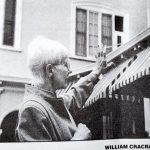Cutline: Mary Ellen Boyling’s love for the house is obvious as she explains Ralston Hall’s history.
Mary Ellen Boyling has been part and parcel of Ralston Hall since she was a house mother in the Hall 41 years ago.
She realized she was neckdeep when she was handed a set of keys. “I discovered that so much was here. We had some money we had been given to paint and so forth and somebody had to be in charge.
“I started out as a resident assistant and taught one class in English. I was finishing up a master’s degree and living in a room up here that had 38 freshmen women, too many, in 1957.
“They were completing the new dorm, so they moved the students in here and moved the sisters upstairs. I was 27,” said Boyling. She was made interim chair of the English department in 1962 when the sister in charge fell ill. Eleven years later she received her doctorate in American literature from Stanford. Her interim appointment turned into a 21-year chairmanship, during which she taught English and American Literature.
A native New Yorker, Boyling came west in 1952 and never looked back. Now in San Francisco, she has lived in Belmont for almost 40 years after moving from Ralston Hall.
Boyling happened into the job of keeper and curator. Sister Catherine Julie Cunningham, former president and chancellor of the college who pushed for landmark status, tagged Boyling for general supervisory duties in the hall.
When she died, “The thenpresident asked me to join the society and asked would I keep an eye on the docents and keep the volunteer group going,” Boyling said. She retired in 1993 but ran the hall for a small stipend until 1995. Now she cares for the home on her own.
Her passion shines through as she espouses her theory on the home’s foundation. Count Leonetto Cipriani built a modest villa in 1853. William Ralston bought the property and Boyling theorizes he built around the Cipriani structure. Other historians believe the Cipriani structure was razed and an entirely new building constructed.
“We do have a footnote that says the house was torn down, I believe it was a major news account.” said Michael Svanivik, San Mateo County historian. Boyling is standing her ground.
She pointed out the difference in window placement between what she believes to be the Cipriani core and the Ralston expansion. “The house was 10 years old when Ralston bought the property; you don’t tear down a house like that. I have seen the foundation of the Cipriani house inside underneath, I can show you a wall inside on the second floor that has been enveloped.” Inside, Boyling pointed out small grills at regular intervals around ceiling moldings. “This is a wonderful ventilating system. This is one of my arguments about the Cipriani house. These are not in (the Cipriani) part of the house, but they’re all through the first floor here as part of the ventilation system.”
Another point Boyling makes, the only interior clear glass is the glass wall between the conservatory and the Cipriani room. She believes this wall was the rear exterior wall of the Cipriani house. In addition, the floor of the Cipriani room is an inch higher than the floor of the conservatory and the Cipriani room is almost a perfect square, while all the other spaces are oblong.
Boyling’s mandate is to preserve the history and adapt as needed. She bemoans the use of the hall for administrative offices while recognizing the building has to be functional. Her job is to ensure as few alterations of the home are made as possible, to mitigate wear and tear.
“I am writing a history of the house and I keep getting distracted. I’ve come to be seen as the curator, the historian of the house by virtue of experience; I have no prior training,” she said.
“The different periods of ownership are important. I think that’s a way to develop (the history) …
“The other side of preserving the history, is what the building looks like and this to me is what should be important here. The way it looks, the wonderful way it was built and the quality of what went into it and the fact that so much of it is still here.”
This article was written by William Cracraft/Freelance News Service and first published in 1998 in the 75th Anniversary Edition tabloid published by Alameda News Paper Group. Any accompanying photos were also taken by William Cracraft. It is reproduced here as a portfolio piece.
Latest News
- Teachers bring new methodologies, in-depth studies and sunshine to classrooms through Vegesna grants
- Feature: Entrepreneurship and Beyond: Skills learned in incubator classes guide startup development and pay off in life
- Harker Communication Office Wins Prestigious Awards
- Harker Quarterly Wins CASE Award of Excellence
- Harker in the News





